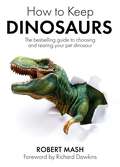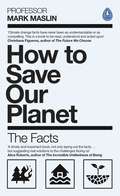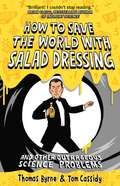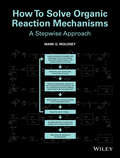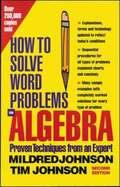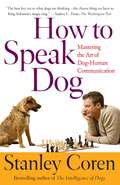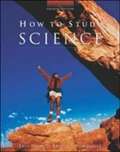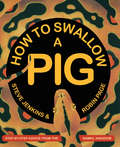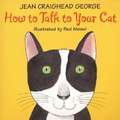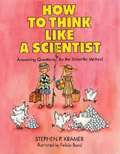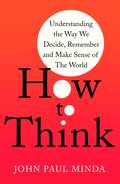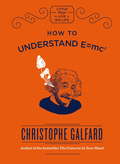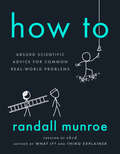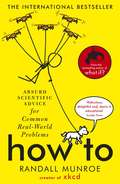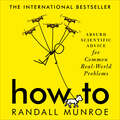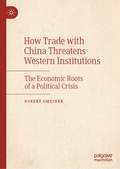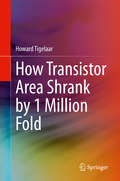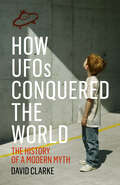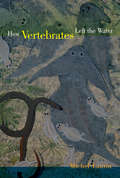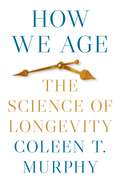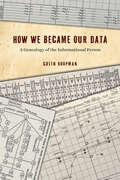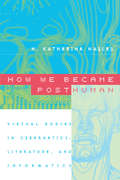- Table View
- List View
How To Keep Dinosaurs: The perfect mix of humour and science
by Robert Mash'Who could resist a handbook about potential pets that has a little symbol for "likes children" and a separate one for "likes children to eat"... wonderful' GUARDIANHollywood and the popular press would have us believe that all dinosaurs are gigantic, hostile and untameable. In fact, there are many species that make charming and even useful companions: Velociraptor - a splendid, loyal, fierce, friendDeinonychus - will not eat dog food (dogs are another matter)Tyrannosaurus - least suitable to keep; will need special licenceOrnithomimus - an appealing first dinosaur for the child anxious for her first rideThis book advises you which dinosaur is right for you and your home, from the city apartment dweller looking for a lap pet, to the country estate owner looking to tighten up on security. HOW TO KEEP DINOSAURS is a bestselling guide, packed with the sort of information keen dinosaur keepers crave - from feeding and housing to curing common ailments, breeding and showing your animal. The author, a zoologist with extensive experience of dinosaurs, has provided a timely and much-needed source book for all those who keep dinosaurs and for the huge numbers who are contemplating getting one. It is as essential to every dinosaur keeper as a stout shovel and a tranquilliser rifle.
How To Make Slime
by Lori ShoresWhat substance can act like both a solid and a liquid? Slime! Want to find out how to make your own? Just follow the simple steps inside this book
How To Save Our Planet: The Facts
by Mark A. Maslin'Punchy and to the point. No beating around the bush. This brilliant book contains all the information we need to have in our back pocket in order to move forward' Christiana Figueres, Former Executive Secretary UN Climate Change Convention'Amazing book' Chris Evans, Virgin Radio Breakfast Show'Everyone should have this book' Rick Edwards, BBC Radio 5 Live'A timely and important book, not only laying out the facts...but suggesting real solutions to the challenges facing us' Professor Alice Roberts, Anatomist, Professor of Public Engagement in Science, University of Birmingham_________________________ How can we save our planet and survive the 21st century? How can you argue with deniers? How can we create positive change in the midst of the climate crisis? Professor Mark Maslin has the key facts that we need to protect our future. Global awareness of climate change is growing rapidly. Science has proven that our planet and species are facing a massive environmental crisis. How to Save Our Planet is a call to action, guaranteed to equip everyone with the knowledge needed to make change. Be under no illusion the challenges of the twenty-first century are immense. We need to deal with: climate change, environmental destruction, global poverty and ensure everyone's security. We have the technology. We have the resources. We have the money. We have the scientists, the entrepreneurs and the innovators. We lack the politics and policies to make your vision of a better world happen. So we need a plan to save our planet... How to Save Our Planet is your handbook of how we together can save our precious planet. From the history of our planet and species, to the potential of individuals and our power to create a better future, Maslin inspires optimism in these bleak times. We stand at the precipice. The future of our planet is in our hands. It's time to face the facts and save our planet from, and for, ourselves._________________________'A handbook of clearly established, authoritative facts and figures about the terrible toll we as humans have taken of our planet, plus ways in which we can lessen the impact. For laypeople like me, who can see what is happening but haven't always got the precise statistics to hand, it's hugely valuable' John Simpson CBE, BBC World Affairs Editor, Broadcaster, Author & Columnist'Saving the world is no small thing, but picking up this book's a good start' Paris Lees, Contributing Editor at British Vogue, campaigner'I love it. My kids love it' Chris Evans, Virgin Radio Breakfast Show'A no-nonsense crib sheet on the state of the world and how to help it' The I Newspaper
How To Save the World with Salad Dressing: and Other Outrageous Science Problems
by Thomas Byrne Tom CassidyWho said that physics has to be dull? In this rip-roaring science puzzle adventure, Byrne and Cassidy put the reader in the driving seat. Is a truck containing a bird lighter when the bird is flying or on a perch? Why does the stream from a tap get increasingly thinner? Can you speed up light? Is time travel possible? Featuring a cast of odd-ball characters and a laugh-out-loud storyline, Byrne and Cassidy explain the basic principles of modern science and guide the reader in working out the rest. With thirty stimulating mindbenders of varying difficulty, including detailed clues and answers for each problem, How to Save the World with Salad Dressing is the perfect book for anyone with an interest in science or mathematics. Thomas Byrne is a fledgling genius and professional puzzle writer. Thomas Cassidy is former teacher and Oxford University Physics graduate. He is married to a Texan and spends much of the year in Austin. They are the authors of How to Win at Russian Roulette: And Other Outrageous Logic Problems
How To Solve Organic Reaction Mechanisms
by Mark G. MoloneyHow To Solve Organic Reaction Mechanisms: A Stepwise Approach is an upgraded and much-expanded sequel to the bestselling text Reaction Mechanisms at a Glance. This book takes a unique approach to show that a general problem-solving strategy is applicable to many of the common reactions of organic chemistry, demonstrating that logical and stepwise reasoning, in combination with a good understanding of the fundamentals, is a powerful tool to apply to the solution of problems.Sub-divided by functional group, the book uses a check-list approach to problem-solving using mechanistic organic chemistry as its basis. Each mechanistic problem is presented as a two-page spread; the left-hand page introduces the problem and provides a stepwise procedure for working through the reaction mechanisms, with helpful hints about the underlying chemistry. The right-hand page contains the full worked solution and summary.This revised edition includes the following updates:* A new chapter which applies the problem solving strategy to ligand coupling reactions using transition metals* Much-expanded set of fully worked problems* Over 40 further problems (with answers for tutors) for use in tutorialsHow To Solve Organic Reaction Mechanisms: A Stepwise Approach is an essential workbook for all students studying organic chemistry, and a useful aide for teachers of undergraduate organic chemistry to use in their tutorials.
How To Solve Word Problems In Algebra, 2nd edition
by Mildred Johnson Tim Johnson"There is no area in algebra which causes students as much difficulty as word problems. Most textbooks in algebra do not have adequate explanations and examples for the student who is having trouble with them...All major types of word problems usually found in algebra texts are here. Emphasis is on the mechanics of word-problem solving because it has been my experience that students having difficulty can learn basic procedures even if they are unable to reason out a problem." Author.
How To Speak Dog: Mastering the Art of Dog-Human Communication
by Stanley Coren&“A must read for all dog owners.&” —The Washington Post &“The best key to what dogs are thinking.&” —The Seattle Times How to Speak Dog is one of the few books today that show us what dogs are trying to tell us, not just how we can control them. Parlez-vous Doggish? At long last, dogs will know just how smart their owners can be. By unlocking the secrets of the hidden language of dogs, psychologist Stanley Coren allows us into the doggy dialogue, or “Doggish,” and makes effective communication a reality. Drawing on substantial research in animal behavior, evolutionary biology, and years of personal experience, Coren demonstrates that the average house dog can understand language at about the level of a two-year-old human. While actual conversation of the sort Lassie seemed capable of in Hollywood mythmaking remains forever out of reach, Coren shows us that a great deal of real communication is possible beyond the giving and obeying of commands. How to Speak Dog not only provides the sounds, words, actions, and movements with which we can effectively communicate with our dogs, but also deciphers the signs that our dogs give to us. With easy-to-follow tips on how humans can mimic the language dogs use to talk with one another, original drawings illustrating the subtleties of their body language, and a handy visual glossary and “Doggish” phrasebook, How to Speak Dog gives dog lovers the skills they need to improve their relationships with their pets.
How To Study Science
by Kristin L. D. Milligan Fred DrewesThis inexpensive supplement is especially valuable for students who are uneasy about learning science. It can help them get the most out of their science course by giving them suggestions on note-taking, managing study time, taking tests, and more. This guide can be used in several ways. Individual students may use this book to enhance their study skills, or instructors may use it as a test or supplement for orientation classes, college seminars, or science courses.
How To Swallow A Pig: Step-by-step Advice From The Animal Kingdom
by Steve Jenkins Robin PageIn the latest eye-catching escape into the kingdom of Animalia, Steve Jenkins and Robin Page reveal the skills animals use to survive in the wild in an imaginative and humorous how-to format. With step-by-step instructions, readers learn about specific behaviors; how to catch thousands of fish like a humpback whale or how to sew up a nest like a tailorbird. This fascinating and fun illustrated nonfiction melds science, art, biology, and the environment together in a detailed and well-researched book about animals who live and survive in our world today.
How To Talk To Your Cat
by Jean Craighead George Paul Meisel Sue TruesdellFind out what your cat is really saying -- and talk back! What is your cat telling you when he rubs against your leg? What does it mean when he holds his tail straight up? Discover the different kinds of meows and what they mean; find out how to read whiskers, tails, facial expressions -- and much more! Jean Craighead George, award-winning author of over 80 books about nature and animals, demonstrates in words and photos how to communicate with that ever-mysterious, ever-lovable animal -- the cat. Children's Books 2000-NY Public Lib.
How To Think Like A Scientist: Answering Questions By The Scientific Method
by Felicia Bond Stephen P. KramerEvery day you answer questions-dozens, even hundreds of them. How do you find the answers to questions? How can you be sure your answers are correct? Scientists use questions to learn about things. Scientists have developed a way of helping make sure they answer questions correctly. It is called the scientific method. The scientific method can help you find answers to many of the questions you are curious about. What kind of food does your dog like best? Is your sister more likely to help you with your homework if you say please? Can throwing a dead snake over a tree branch make it rain? The scientific method can help you answer these questions and many others. Stephen Kramer's invitation to think like a scientist, illustrated by Felicia Bond's humorous and appealing pictures, will receive enthusiastic response from young readers, scientist and nonscientist alike.
How To Think: Understanding the Way We Decide, Remember and Make Sense of the World
by John Paul MindaThis book will get you thinking about thinking.We understand more about the brain than ever before and we also have more tools than ever before to help us think. This book will show you how your brain works, how your mind works, why we all make certain mistakes in thinking and why that's not always a bad thing. In order to understand how people behave, you need to understand how people think. And if you want to understand how people think, you need to have a basic understanding of cognitive psychology, cognitive science and cognitive neuroscience. This book explains cognition and the links between the brain, the mind and behaviour in a clear and straightforward way. Through interesting case studies and research examples, Minda shows how the brain is involved in mental activity, how memory works, how language affects thought, how good (and bad) decisions are made, and why we make predictable errors in our thinking. With practical applications for everyday life, this a book that helps us become better thinkers, better learners and better problem-solvers. In the current era of big data, algorithms and AI, Minda argues that knowing about how humans think-how you think-is more important than ever before.
How To Think: Understanding the Way We Decide, Remember and Make Sense of the World
by John Paul MindaThis book will get you thinking about thinking.We understand more about the brain than ever before and we also have more tools than ever before to help us think. This book will show you how your brain works, how your mind works, why we all make certain mistakes in thinking and why that's not always a bad thing. In order to understand how people behave, you need to understand how people think. And if you want to understand how people think, you need to have a basic understanding of cognitive psychology, cognitive science and cognitive neuroscience. This book explains cognition and the links between the brain, the mind and behaviour in a clear and straightforward way. Through interesting case studies and research examples, Minda shows how the brain is involved in mental activity, how memory works, how language affects thought, how good (and bad) decisions are made, and why we make predictable errors in our thinking. With practical applications for everyday life, this a book that helps us become better thinkers, better learners and better problem-solvers. In the current era of big data, algorithms and AI, Minda argues that knowing about how humans think-how you think-is more important than ever before.
How To Understand E =mc²
by Christophe GalfardDo something amazing and learn a new skill thanks to the Little Ways to Live a Big Life books! The beginning of the 20th century heralded a scientific revolution: what a few brilliant minds uncovered about our reality in the first twenty years has shaped the history of our species. And one of them in particular stands out: Einstein, with his celebrated E=mc2.In this remarkable and insightful book, Christophe Galfard describes how E=mc2 is a direct consequence of the Theory of Special Relativity, the theory of how objects move and behave, at speeds close to the speed of light. He considers Einstein's legacy in the light of the 21st century, with fresh hindsight, and considers its impact on our vision of reality. The reader will discover that far from being just a formula, it is a brand new understanding of the nature of space and time.Some of the greatest scientific breakthroughs in the history of science have been made by geniuses who managed to merge and unite hitherto separated domains of knowledge. Galfard explores two unifications with Einstein's theories, and looks at the even bigger picture of how E=mc2 has changed our world, and what it entails for the future.Throughout, Galfard takes the reader on an extremely entertaining journey, using simple, jargon-free language to help the reader gain a deeper understanding of science. With humour and patience, he guides us through the world of particles, anti-matter and much more to bring us closer to an ultimate understanding of reality as we understand it today.
How To Understand E =mc² (Little Ways to Live a Big Life #1)
by Christophe GalfardDo something amazing and learn a new skill thanks to the Little Ways to Live a Big Life books! The beginning of the 20th century heralded a scientific revolution: what a few brilliant minds uncovered about our reality in the first twenty years has shaped the history of our species. And one of them in particular stands out: Einstein, with his celebrated E=mc2.In this remarkable and insightful book, Christophe Galfard describes how E=mc2 is a direct consequence of the Theory of Special Relativity, the theory of how objects move and behave, at speeds close to the speed of light. He considers Einstein's legacy in the light of the 21st century, with fresh hindsight, and considers its impact on our vision of reality. The reader will discover that far from being just a formula, it is a brand new understanding of the nature of space and time.Some of the greatest scientific breakthroughs in the history of science have been made by geniuses who managed to merge and unite hitherto separated domains of knowledge. Galfard explores two unifications with Einstein's theories, and looks at the even bigger picture of how E=mc2 has changed our world, and what it entails for the future.Throughout, Galfard takes the reader on an extremely entertaining journey, using simple, jargon-free language to help the reader gain a deeper understanding of science. With humour and patience, he guides us through the world of particles, anti-matter and much more to bring us closer to an ultimate understanding of reality as we understand it today.
How To: Absurd Scientific Advice for Common Real-World Problems
by Randall MunroeThe world's most entertaining and useless self-help guide, from the brilliant mind behind the wildly popular webcomic xkcd and the #1 New York Times bestsellers What If? and Thing Explainer <P><P>For any task you might want to do, there's a right way, a wrong way, and a way so monumentally complex, excessive, and inadvisable that no one would ever try it. How To is a guide to the third kind of approach. It's full of highly impractical advice for everything from landing a plane to digging a hole. <P><P>Bestselling author and cartoonist Randall Munroe explains how to predict the weather by analyzing the pixels of your Facebook photos. He teaches you how to tell if you're a baby boomer or a 90's kid by measuring the radioactivity of your teeth. He offers tips for taking a selfie with a telescope, crossing a river by boiling it, and powering your house by destroying the fabric of space-time. And if you want to get rid of the book once you're done with it, he walks you through your options for proper disposal, including dissolving it in the ocean, converting it to a vapor, using tectonic plates to subduct it into the Earth's mantle, or launching it into the Sun. <P><P>By exploring the most complicated ways to do simple tasks, Munroe doesn't just make things difficult for himself and his readers. As he did so brilliantly in What If?, Munroe invites us to explore the most absurd reaches of the possible. Full of clever infographics and fun illustrations, How To is a delightfully mind-bending way to better understand the science and technology underlying the things we do every day. <P><P><b>A New York Times Bestseller</b>
How To: Absurd Scientific Advice for Common Real-World Problems from Randall Munroe of xkcd
by Randall MunroeRandall Munroe is . . .'Nerd royalty' Ben Goldacre'Totally brilliant' Tim Harford'Laugh-out-loud funny' Bill Gates'Wonderful' Neil GaimanAN INSTANT #1 NEW YORK TIMES BESTSELLERThe world's most entertaining and useless self-help guide, from the brilliant mind behind the wildly popular webcomic xkcd and the million-selling What If? and Thing Explainer For any task you might want to do, there's a right way, a wrong way, and a way so monumentally bad that no one would ever try it. How To is a guide to the third kind of approach. It's full of highly impractical advice for everything from landing a plane to digging a hole. 'How strange science can fix everyday problems' New Scientist'A brilliant book: clamber in for a wild ride' Nature
How To: Absurd Scientific Advice for Common Real-World Problems from Randall Munroe of xkcd
by Randall MunroeThe world's most entertaining and useless self-help guide, from the brilliant mind behind the wildly popular webcomic xkcd and the million-selling What If? and Thing Explainer.For any task you might want to do, there's a right way, a wrong way, and a way so monumentally bad that no one would ever try it. How To is a guide to the third kind of approach. It's full of highly impractical advice for everything from landing a plane to digging a hole.Bestselling author and cartoonist Randall Munroe explains how to predict the weather by analyzing the pixels of your Facebook photos. He teaches you how to tell if you're a baby boomer or a millennial by measuring the radioactivity of your teeth. He offers tips for taking a selfie with a telescope, crossing a river by boiling it, and getting to your appointments on time by destroying the moon. And if you want to get rid of this book once you're done with it, he walks you through your options for proper disposal, including dissolving it in the ocean, converting it to a vapour, using tectonic plates to subduct it into the Earth's mantle, or launching it into the sun.By exploring the most complicated ways to do simple tasks, Munroe doesn't just make things difficult for himself and his readers. As he did so brilliantly in What If?, he invites us to explore the most absurd reaches of the possible. How To is a delightfully mind-bending way to better understand the science and technology underlying the things we do every day.(P)2019 Penguin Random House Audio
How Trade with China Threatens Western Institutions: The Economic Roots of a Political Crisis
by Robert GmeinerThis book evaluates the institutional environments of China and the United States, and the West more broadly, and how they affect their trading relationship, with specific emphasis on intellectual property theft and other allegations of unfair competition. The economic and political characteristics of the two countries affect the balance of power in their trading relationship, with ramifications far beyond jobs and output. The major theme is China’s ability to free ride on Western institutions through intellectual property theft and extortion. This free riding is far more than just infringing patents and reaping profits; it creates a combination of incentives for political pressures in the West that diminish the free market and liberal Western values. The result is the classic result of free riding – underprovision, or degeneration, of the Western institutions that made the West prosperous and free. At the same time, China’s economic might, military prowess, and global soft power increase, often with deleterious effects for freedom and free markets. This book is distinctive because it integrates public choice ideas about economic institutions, state action, and strategic behavior into international trade. It also takes account of the economic characteristics of China and the West and explains why they present a situation that is fundamentally different from other trade disputes. Institutions and political influence are central to this book’s analysis of trade, which can be more dangerous and more disguised than the welfare gains from trade. Providing a concise and lucid distillation of pressing issues, this book is critical reading for scholars studying trade with China and its effects on both global and Western innovation, economic output, soft power, and freedom more broadly.
How Transistor Area Shrank by 1 Million Fold
by Howard TigelaarThis book explains in layman’s terms how CMOS transistors work. The author explains step-by-step how CMOS transistors are built, along with an explanation of the purpose of each process step. He describes for readers the key inventions and developments in science and engineering that overcame huge obstacles, enabling engineers to shrink transistor area by over 1 million fold and build billions of transistor switches that switch over a billion times a second, all on a piece of silicon smaller than a thumbnail.
How UFOs Conquered the World: The History of a Modern Myth
by David Clarke“Cover[s] all the major themes of ufology, ranging from lights in the sky to crashed saucers, government cover-ups and alien abductions . . . fascinating.” —Popular Science BooksNeither a credulous work of conspiracy theory nor a skeptical debunking of belief in “flying saucers,” How UFOs Conquered the World explores the origins of UFOs in the build-up to the First World War and how reports of them have changed in tandem with world events, science and culture. The book will also explore the overlaps between UFO belief and religion and superstition.“An insightful, informative and thought-provoking book on UFOs and the UFO culture . . . In the following ten chapters, he writes about his pursuit of the ‘truth’ about UFOs. It is a fascinating journey.” —Skeptic
How Vertebrates Left the Water
by Michel LaurinMore than three hundred million years ago--a relatively recent date in the two billion years since life first appeared--vertebrate animals first ventured onto land. This usefully illustrated book describes how some finned vertebrates acquired limbs, giving rise to more than 25,000 extant tetrapod species. Michel Laurin uses paleontological, geological, physiological, and comparative anatomical data to describe this monumental event. He summarizes key concepts of modern paleontological research, including biological nomenclature, paleontological and molecular dating, and the methods used to infer phylogeny and character evolution. Along with a discussion of the evolutionary pressures that may have led vertebrates onto dry land, the book also shows how extant vertebrates yield clues about the conquest of land and how scientists uncover evolutionary history.
How We Age: The Science of Longevity
by Coleen T. MurphyHow recent breakthroughs in longevity research offer clues about human agingAll of us would like to live longer, or to slow the debilitating effects of age. In How We Age, Coleen Murphy shows how recent research on longevity and aging may be bringing us closer to this goal. Murphy, a leading scholar of aging, explains that the study of model systems, particularly simple invertebrate animals, combined with breakthroughs in genomic methods, have allowed scientists to probe the molecular mechanisms of longevity and aging. Understanding the fundamental biological rules that govern aging in model systems provides clues about how we might slow human aging, which could lead in turn to new therapeutics and treatments for age-related disease.Among other vivid examples, Murphy describes research that shows how changing a single gene in the nematode worm C. elegans doubles its lifespan, extending not only the end of life but also the youthful, healthy part of life. Drawing on work in her own lab as well as other recent research, Murphy chronicles the history and current state of the field, explaining longevity’s links to reproduction and mating, sensory and cognitive function, inheritances from our ancestors, and the gut microbiome. Written with clarity and wit, How We Age provides a guide to the science: what we know about aging, how we know what we know, and what we can do with this new knowledge.
How We Became Our Data: A Genealogy of the Informational Person
by Colin KoopmanWe are now acutely aware, as if all of the sudden, that data matters enormously to how we live. How did information come to be so integral to what we can do? How did we become people who effortlessly present our lives in social media profiles and who are meticulously recorded in state surveillance dossiers and online marketing databases? What is the story behind data coming to matter so much to who we are? In How We Became Our Data, Colin Koopman excavates early moments of our rapidly accelerating data-tracking technologies and their consequences for how we think of and express our selfhood today. Koopman explores the emergence of mass-scale record keeping systems like birth certificates and social security numbers, as well as new data techniques for categorizing personality traits, measuring intelligence, and even racializing subjects. This all culminates in what Koopman calls the “informational person” and the “informational power” we are now subject to. The recent explosion of digital technologies that are turning us into a series of algorithmic data points is shown to have a deeper and more turbulent past than we commonly think. Blending philosophy, history, political theory, and media theory in conversation with thinkers like Michel Foucault, Jürgen Habermas, and Friedrich Kittler, Koopman presents an illuminating perspective on how we have come to think of our personhood—and how we can resist its erosion.
How We Became Posthuman: Virtual Bodies in Cybernetics, Literature, and Informatics
by N. Katherine HaylesIn this age of DNA computers and artificial intelligence, information is becoming disembodied even as the "bodies" that once carried it vanish into virtuality. While some marvel at these changes, envisioning consciousness downloaded into a computer or humans "beamed" Star Trek-style, others view them with horror, seeing monsters brooding in the machines. In How We Became Posthuman, N. Katherine Hayles separates hype from fact, investigating the fate of embodiment in an information age. Hayles relates three interwoven stories: how information lost its body, that is, how it came to be conceptualized as an entity separate from the material forms that carry it; the cultural and technological construction of the cyborg; and the dismantling of the liberal humanist "subject" in cybernetic discourse, along with the emergence of the "posthuman." Ranging widely across the history of technology, cultural studies, and literary criticism, Hayles shows what had to be erased, forgotten, and elided to conceive of information as a disembodied entity. Thus she moves from the post-World War II Macy Conferences on cybernetics to the 1952 novel Limbo by cybernetics aficionado Bernard Wolfe; from the concept of self-making to Philip K. Dick's literary explorations of hallucination and reality; and from artificial life to postmodern novels exploring the implications of seeing humans as cybernetic systems. Although becoming posthuman can be nightmarish, Hayles shows how it can also be liberating. From the birth of cybernetics to artificial life, How We Became Posthuman provides an indispensable account of how we arrived in our virtual age, and of where we might go from here.
